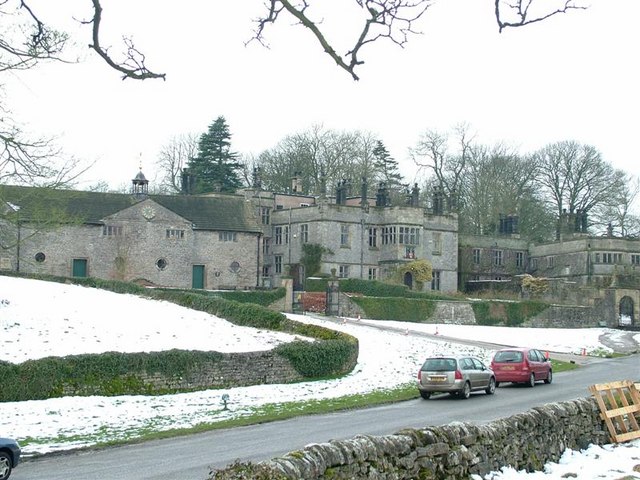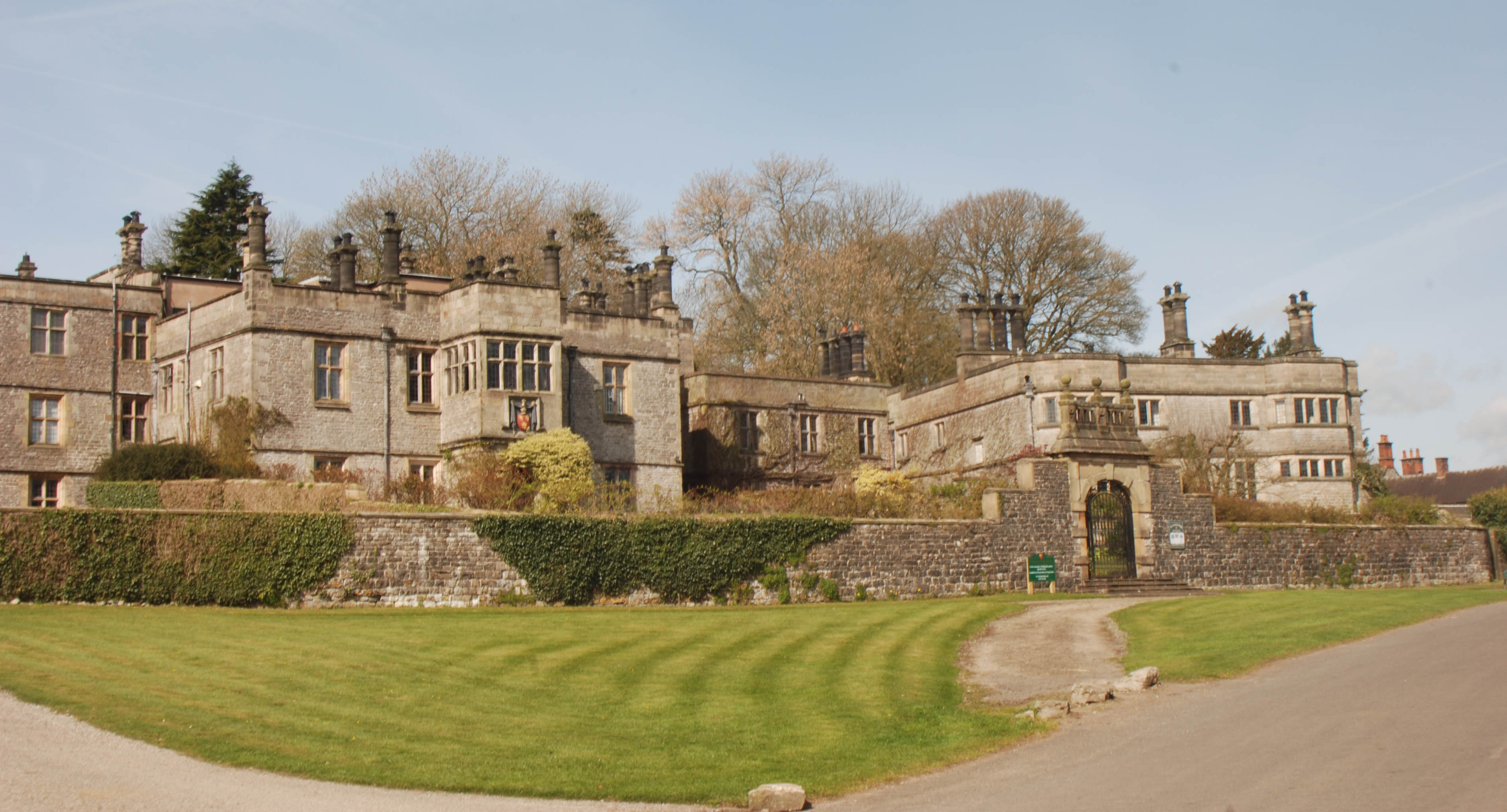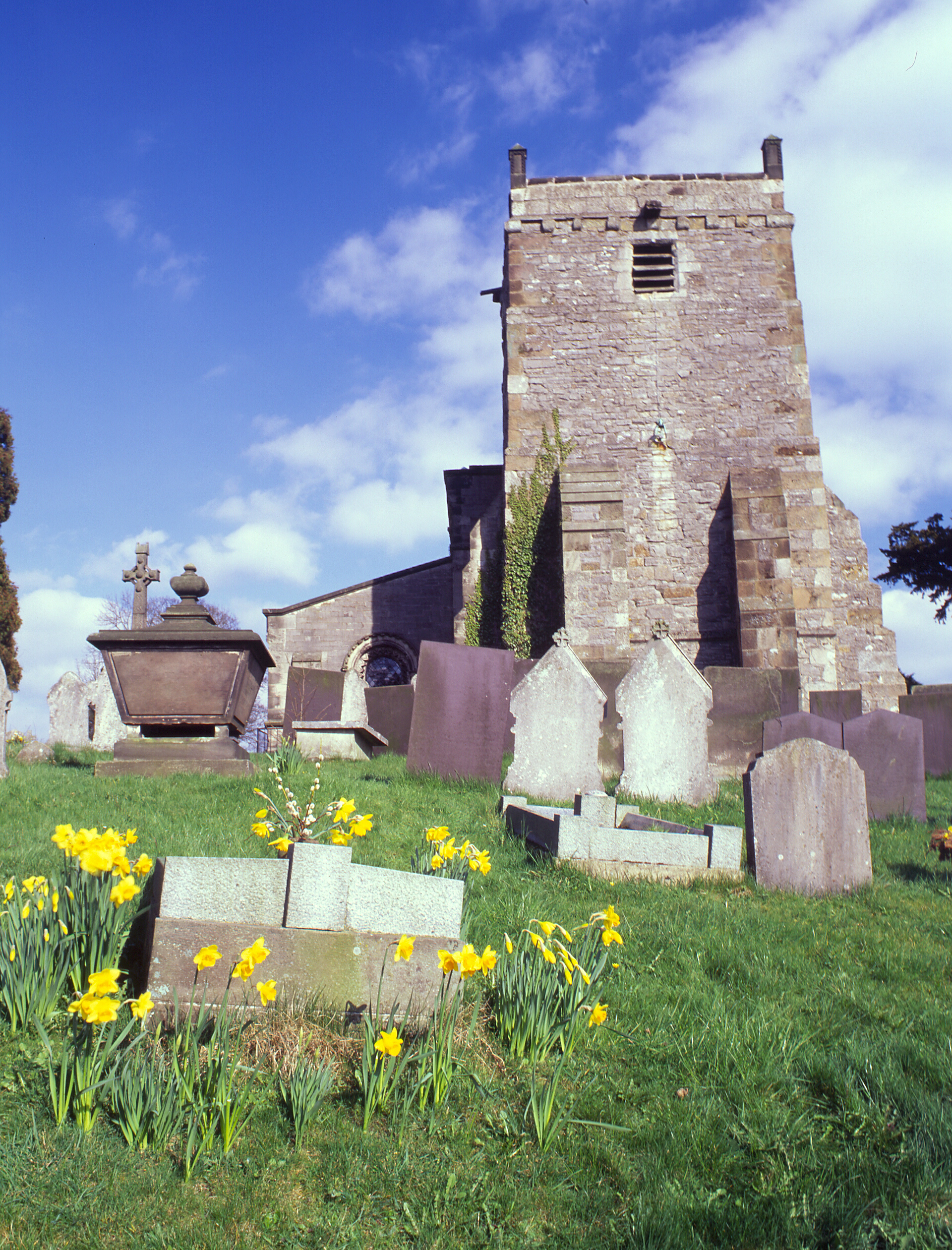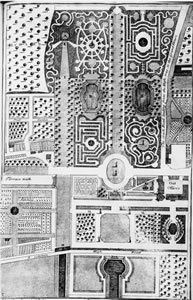|
Tissington Hall
Tissington Hall is an early 17th-century Jacobean mansion house in Tissington, near Ashbourne, Derbyshire. It is a Grade II* listed building. The FitzHerberts, descended from the Norman family of Norbury Hall, acquired Tissington by the marriage of Nicholas FitzHerbert (the second son of John FitzHerbert of Somersal Herbert) to Ciceley Frauncis, heiress of Tissington, in 1465. The old moated manor at Tissington was replaced with the new mansion in 1609 by Francis FitzHerbert and remains the home of the FitzHerbert family. The current occupant is Sir Richard FitzHerbert, 9th Baronet. Both Francis FitzHerbert and his son (Sir) John served as High Sheriff of Derbyshire, a post that circulated among the county families. It is the hall that makes Tissington Hall unusual. It is one of a small group of compact Derbyshire gentry houses in which a central hall runs through the house from front to back. Nicholas Cooper surmises that the unusual, progressive character may be due to t ... [...More Info...] [...Related Items...] OR: [Wikipedia] [Google] [Baidu] |
Tissington Hall Front
Tissington is a village in the Derbyshire Dales district of Derbyshire, England. The appropriate civil parish is called Tissington and Lea Hall. The population of this parish at the 2011 census was 159. It is part of the estate of Tissington Hall, owned by the FitzHerbert family since 1465. It is a popular tourist attraction, particularly during its well dressing week. It also gives its name to the Tissington Trail, a walk and cycle path which passes nearby. The Limestone Way, another long-distance path and bridleway, passes through the village itself. History Tissington (Old English "Tidsige's farm/settlement") is recorded in the Domesday Book of 1086 as ''Tizinctun'', having been given to Henry de FerrersHenry was given a large number of manors throughout England, but particularly in Derbyshire. by the King: "In Tizinctun Ulchel, Edric, Ganel, Uluiet, Wictric, Leuric, Godwin had 4 carucates of land for geld. Land for 4 ploughs. Now in the demesne there (are) 3 ploughs: ... [...More Info...] [...Related Items...] OR: [Wikipedia] [Google] [Baidu] |
Hardwick Hall
Hardwick Hall in Derbyshire is an architecturally significant country house from the Elizabethan era, a leading example of the Elizabethan prodigy house. Built between 1590 and 1597 for Bess of Hardwick, it was designed by the architect Robert Smythson, an exponent of the Renaissance style. Hardwick Hall is one of the earliest examples of the English interpretation of this style, which came into fashion having slowly spread from Florence. Its arrival in Britain coincided with the period when it was no longer necessary or legal to fortify a domestic dwelling. After ownership for centuries by the Cavendish family and the line of the Earl of Devonshire and the Duke of Devonshire, ownership of the house was transferred to the Treasury in 1956 and then to the National Trust in 1959. The building was ruinous and required stabilisation and a subsequent restoration. The Hall is fully open to the public and received 298,283 visitors in 2019. History 16th century Sited on a hillt ... [...More Info...] [...Related Items...] OR: [Wikipedia] [Google] [Baidu] |
Country Houses In Derbyshire
A country is a distinct part of the world, such as a state, nation, or other political entity. It may be a sovereign state or make up one part of a larger state. For example, the country of Japan is an independent, sovereign state, while the country of Wales is a component of a multi-part sovereign state, the United Kingdom. A country may be a historically sovereign area (such as Korea), a currently sovereign territory with a unified government (such as Senegal), or a non-sovereign geographic region associated with certain distinct political, ethnic, or cultural characteristics (such as the Basque Country). The definition and usage of the word "country" is flexible and has changed over time. ''The Economist'' wrote in 2010 that "any attempt to find a clear definition of a country soon runs into a thicket of exceptions and anomalies." Most sovereign states, but not all countries, are members of the United Nations. The largest country by area is Russia, while the smallest ... [...More Info...] [...Related Items...] OR: [Wikipedia] [Google] [Baidu] |
History Of Derbyshire
The history of Derbyshire can be traced back to human settlement since the last Ice Age, over 10,000 years ago. The county of Derbyshire in England dates back to the 11th century. The origins of Derbyshire Derbyshire is first mentioned in the ''Anglo-Saxon Chronicle'' in 1048 in Manuscript D, known as the "Northern Recension". Its creation appears to be a result of the dismemberment of the Mercian Kingdom's province of the Peak District and the chronicle says, under 1048: “her wæs eac eorðstyrung on Kalendas Maias on manegum stowum, on Wygracestre on Wic on Deorby elles gehwær, eac wæs swiðe mycel mancwealm orfcwealm, eac þæt wilde fyr on Deorbyscire micel yfel dyde gehwær elles.” ("This year also there was an earthquake, on the calends of May, in many places; at Worcester, at Wick, and at Derby, and elsewhere wide throughout England; with very great loss by disease of men and of cattle over all England; and the wild fire in Derbyshire and elsewhere did much harm"). ... [...More Info...] [...Related Items...] OR: [Wikipedia] [Google] [Baidu] |
Grade II* Listed Buildings In Derbyshire
The county of Derbyshire is divided into nine districts. The districts of Derbyshire are High Peak, Derbyshire Dales, South Derbyshire, Erewash, Amber Valley, North East Derbyshire, Chesterfield, Bolsover, and Derby. As there are 460 Grade II* listed buildings in the county they have been split into separate lists for each district. * Grade II* listed buildings in Amber Valley * Grade II* listed buildings in Bolsover (district) * Grade II* listed buildings in Chesterfield * Grade II* listed buildings in Derby * Grade II* listed buildings in Derbyshire Dales * Grade II* listed buildings in Erewash * Grade II* listed buildings in High Peak * Grade II* listed buildings in North East Derbyshire * Grade II* listed buildings in South Derbyshire See also * Grade I listed buildings in Derbyshire There are over 9000 Grade I listed buildings in England. This page is a list of these buildings in the county of Derbyshire, sub-divided by district. Amber Valley ... [...More Info...] [...Related Items...] OR: [Wikipedia] [Google] [Baidu] |
Tissington Trail
The Tissington Trail is a bridleway, footpath and cycleway in Derbyshire, England, along part of the trackbed of the former railway line connecting Ashbourne to Buxton. It takes its name from the village of Tissington, which it skirts. Opened in 1971, and now a part of the National Cycle Network, it stretches for from Parsley Hay in the north to Ashbourne in the south. Route details At Parsley Hay, a small settlement to the north-east of Hartington, it is joined by the High Peak Trail, another rail trail which is in length from High Peak Junction, near Cromford in Matlock, to Dowlow, near Buxton. The trail has a firm crushed-limestone surface, which is suitable for cyclists, walkers and wheelchair users. It has easy level access at many points along its route. The elevated nature of the line (at Parsley Hay, it is over above sea level) means that it affords good views, but it is exposed in poor weather. The trail runs gently downhill from Parsley Hay sout ... [...More Info...] [...Related Items...] OR: [Wikipedia] [Google] [Baidu] |
Listed Buildings In Tissington And Lea Hall
Tissington and Lea Hall is a civil parish in the Derbyshire Dales district of Derbyshire, England. The parish contains 41 listed buildings that are recorded in the National Heritage List for England. Of these, two are listed at Grade II*, the middle of the three grades, and the others are at Grade II, the lowest grade. The parish contains the village of Tissington Tissington is a village in the Derbyshire Dales district of Derbyshire, England. The appropriate civil parish is called Tissington and Lea Hall. The population of this parish at the 2011 census was 159. It is part of the estate of Tissington Ha ... and the surrounding countryside. Most of the listed buildings are houses, cottages and associated structures, farmhouses and farm buildings. The other listed buildings include four wells in the village, a church, a milestone, and a telephone kiosk. __NOTOC__ Key Buildings References Citations Sources * * * * * * * * * * * * * * * * * * * * * * * * * * * * * * * ... [...More Info...] [...Related Items...] OR: [Wikipedia] [Google] [Baidu] |
Grade II* Listed Buildings In Derbyshire Dales
There are over 20,000 Grade II* listed buildings in England. This page is a list of these buildings in the district of Derbyshire Dales in Derbyshire. List of buildings See also * Grade I listed buildings in Derbyshire * Grade II* listed buildings in Derbyshire ** Grade II* listed buildings in Amber Valley ** Grade II* listed buildings in Bolsover (district) ** Grade II* listed buildings in Chesterfield ** Grade II* listed buildings in Derby ** Grade II* listed buildings in Erewash ** Grade II* listed buildings in High Peak There are over 20,000 Grade II* listed buildings in England. This page is a list of these buildings in the district of High Peak in Derbyshire. List of buildings See also * Grade I listed buildings in Derbyshire * Grade II ... ** Grade II* listed buildings in North East Derbyshire ** Grade II* l ... [...More Info...] [...Related Items...] OR: [Wikipedia] [Google] [Baidu] |
Tissington Hall2
Tissington is a village in the Derbyshire Dales district of Derbyshire, England. The appropriate civil parish is called Tissington and Lea Hall. The population of this parish at the 2011 census was 159. It is part of the estate of Tissington Hall, owned by the FitzHerbert family since 1465. It is a popular tourist attraction, particularly during its well dressing week. It also gives its name to the Tissington Trail, a walk and cycle path which passes nearby. The Limestone Way, another long-distance path and bridleway, passes through the village itself. History Tissington (Old English "Tidsige's farm/settlement") is recorded in the Domesday Book of 1086 as ''Tizinctun'', having been given to Henry de FerrersHenry was given a large number of manors throughout England, but particularly in Derbyshire. by the King: "In Tizinctun Ulchel, Edric, Ganel, Uluiet, Wictric, Leuric, Godwin had 4 carucates of land for geld. Land for 4 ploughs. Now in the demesne there (are) 3 ploughs: ... [...More Info...] [...Related Items...] OR: [Wikipedia] [Google] [Baidu] |
Howard Colvin
Sir Howard Montagu Colvin (15 October 1919 – 27 December 2007) was a British architectural historian who produced two of the most outstanding works of scholarship in his field: ''A Biographical Dictionary of British Architects, 1600–1840'' and ''The History of the King's Works''. Life and works Born in Sidcup, Colvin was educated at Trent College and University College London. In 1948, he became a Fellow of St John's College, Oxford where he remained until his death in 2007. He was a member of the Royal Commission on the Historical Monuments of England 1963–76, the Historic Buildings Council for England 1970–84, the Royal Fine Art Commission 1962–72, and other official bodies. He is most notably the author of ''A Biographical Dictionary of British Architects, 1600–1840'' which appeared in its original form in 1954. Yale University Press produced a third edition in 1995, and he had just completed his work on the fourth edition at the time of his death. On first p ... [...More Info...] [...Related Items...] OR: [Wikipedia] [Google] [Baidu] |
Batty Langley
Batty Langley (''baptised'' 14 September 1696 – 3 March 1751) was an English garden designer, and prolific writer who produced a number of engraved designs for "Gothick" structures, summerhouses and garden seats in the years before the mid-18th century. An eccentric landscape designer, he gave four of his sons the names Hiram, Euclid, Vitruvius and Archimedes. He published extensively, and attempted to "improve" Gothic forms by giving them classical proportions. Early life Langley was baptised in Twickenham, Middlesex, the son of a jobbing gardener Daniel Langley and his wife Elizabeth. He bore the name of David Batty, one of his father's patrons. He started worked as a gardener, inheriting some of his father's clients in Twickenham, then a village of suburban villas within easy reach of London by a pleasant water journey on the Thames. An early client was Thomas Vernon of Twickenham Park. He married Anne Smith in February 1719. They had four children, but she died in Ju ... [...More Info...] [...Related Items...] OR: [Wikipedia] [Google] [Baidu] |
Gothic Revival
Gothic Revival (also referred to as Victorian Gothic, neo-Gothic, or Gothick) is an architectural movement that began in the late 1740s in England. The movement gained momentum and expanded in the first half of the 19th century, as increasingly serious and learned admirers of the neo-Gothic styles sought to revive medieval Gothic architecture, intending to complement or even supersede the neoclassical styles prevalent at the time. Gothic Revival draws upon features of medieval examples, including decorative patterns, finials, lancet windows, and hood moulds. By the middle of the 19th century, Gothic had become the preeminent architectural style in the Western world, only to fall out of fashion in the 1880s and early 1890s. The Gothic Revival movement's roots are intertwined with philosophical movements associated with Catholicism and a re-awakening of high church or Anglo-Catholic belief concerned by the growth of religious nonconformism. Ultimately, the "Anglo-Catholicism" t ... [...More Info...] [...Related Items...] OR: [Wikipedia] [Google] [Baidu] |


.jpg)

Feb2006.jpg)




